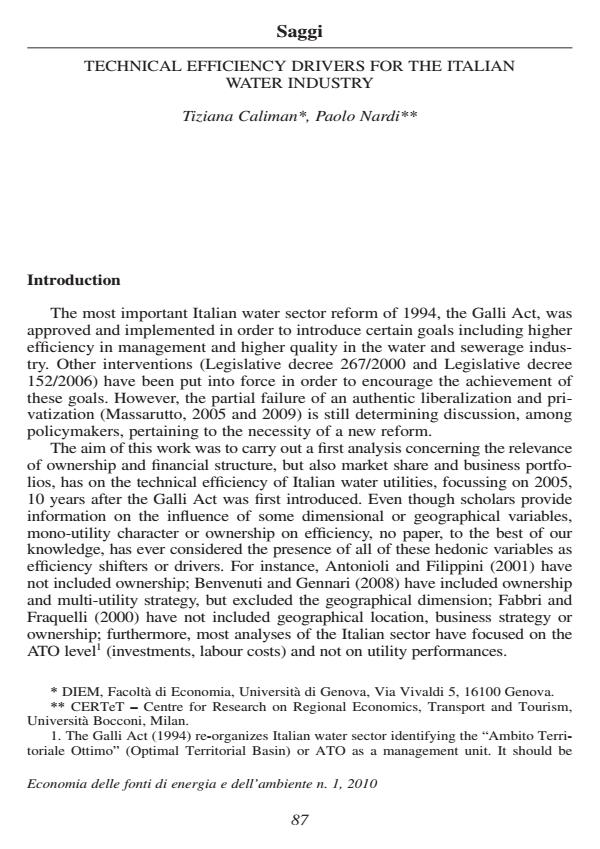Technical efficiency drivers for the Italian water industry
Journal title ECONOMIA DELLE FONTI DI ENERGIA E DELL’AMBIENTE
Author/s Tiziana Caliman, Paolo Nardi
Publishing Year 2010 Issue 2010/1
Language English Pages 17 P. 87-103 File size 602 KB
DOI 10.3280/EFE2010-001008
DOI is like a bar code for intellectual property: to have more infomation
click here
Below, you can see the article first page
If you want to buy this article in PDF format, you can do it, following the instructions to buy download credits

FrancoAngeli is member of Publishers International Linking Association, Inc (PILA), a not-for-profit association which run the CrossRef service enabling links to and from online scholarly content.
The aim of this work is to introduce a first analysis concerning the relevance that ownership and financial structure, but also market dimension and business portfolios, have on the technical efficiency of Italian water utilities. Even though scholars have provided information on the influence of some dimensional or geographical variables, mono-utility character or ownership on efficiency, no paper, to the best of our knowledge, has ever considered the presence of all these hedonic variables as efficiency shifters or drivers. Antonioli and Filippini (2001) have not included ownership; Benvenuti and Gennari (2008) have included ownership and multi-utility strategy, but excluded the geographical dimension; Fabbri and Fraquelli (2000) have not included geographical location, business strategy or ownership; furthermore, most analyses of the Italian water sector have focused on the ATO level (investments, labour costs) and not on utility performances. We have estimated four heteroskedastic stochastic production frontiers: two different parametric models, where the hedonic dummy mono is either in the model as an additional variable or it is used to parameterize the variance of the inefficiency term; two competitive statistical formulations have also been introduced to specify the inefficiency component distribution, that is, the half normal and the exponential distributions. The most important findings of this paper can be summarized as follows. The labour, capital and other input elasticities are always highly significant, positive and quite stable in all the performed models, as expected for a well-behaved production function. The main results show that the mono-business strategy is not efficient; at the same time, operating water and sewerage together implies higher efficiency than water- only management. Theoretically, the population density can have an ambiguous effect on efficiency: on one hand, it could be more expensive to serve dispersed customers, but, on the other, it could generate congestion problems. It could be argued that the second effect prevails, therefore a higher density is accompanied by a higher inef- ficiency. The analysis points out that the variance of the idiosyncratic term is a function of the size of the firm, which is measured as the number of connected properties; the null hypothesis, that the firms use a constant returns-to-scale technology, has also been rejected. Considering the 1994 reform, it is possible to state that the integration of water and sewerage has substantially been positive; at the same time, the economies of scale and the ambiguity of density justify the division into provincial basins. The role of the private sector in the water industry, in agreement with previous literature, has neither a positive nor a negative impact on efficiency and ownership is simply not influent [obviously the quality of service should be considered, although the same indifference seems to emerge (Dore et al., 2001)]. Southern Italy suffers from a higher degree of inefficiency (also recently confirmed by Svimez, 2009), and this is probably the most important issue that has to be dealt with, because of the risks of drought and watering bans in those Regions during summer.
Keywords: Water Sector; Technical Efficiency; Drivers
Jel codes: L33, L95
- Être (public), ou ne pas être: est-ce là la question pour le service de l'eau en Italie? Tiziana Caliman, Paolo Nardi, in Flux /2011 pp.24
DOI: 10.3917/flux.083.0024
Tiziana Caliman, Paolo Nardi, Technical efficiency drivers for the Italian water industry in "ECONOMIA DELLE FONTI DI ENERGIA E DELL’AMBIENTE" 1/2010, pp 87-103, DOI: 10.3280/EFE2010-001008